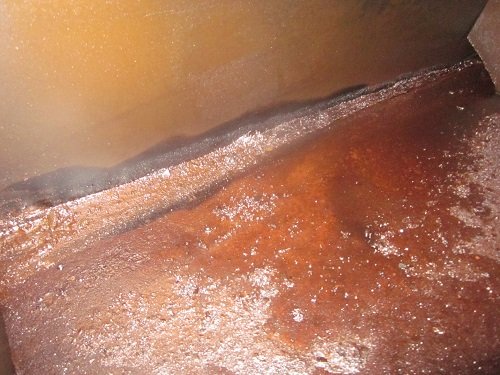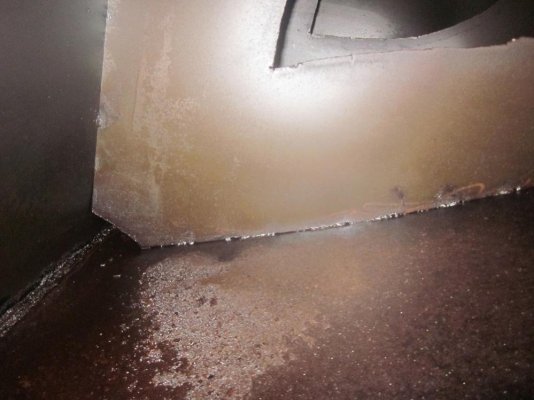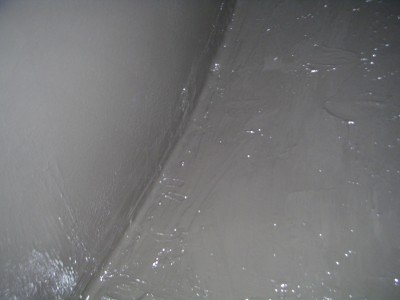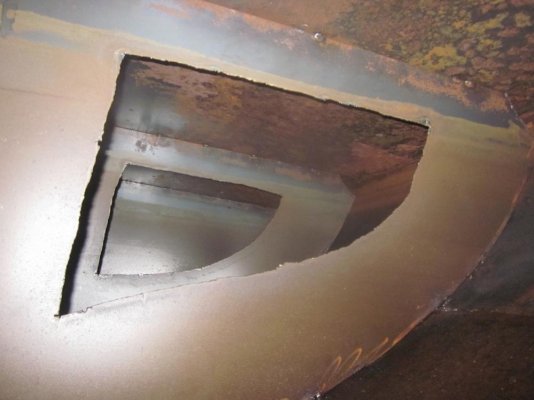You are using an out of date browser. It may not display this or other websites correctly.
You should upgrade or use an alternative browser.
You should upgrade or use an alternative browser.
Steel fuel tank age survey
- Thread starter fryedaze
- Start date
The friendliest place on the web for anyone who enjoys boating.
If you have answers, please help by responding to the unanswered posts.
If you have answers, please help by responding to the unanswered posts.
SomeSailor
Guru
- Joined
- Oct 22, 2011
- Messages
- 784
- Vessel Name
- Honey Badger
- Vessel Make
- 42' CHB Europa
Mine are 34 years old and when I had them open this fall for inspection and polishing, they were in good shape. No leaks or major rust.
27 years old. No leaks or exterior rust. We're in the process of servicing them (2-350 gallon) by adding another inspection port, cleaning and coating the interior bottoms and sides with Flamemaster CS3204. Hopefully they'll be good for another 27 years. 
http://www.flamemaster.com/Technicals PDF/CS3204 rev 01-07.pdf
http://www.flamemaster.com/Technicals PDF/CS3204 rev 01-07.pdf
Last edited:
CPseudonym
Moderator Emeritus
47 years. It was pulled, sandblasted, inspected and painted 2 years ago as part of a refit. Tank was determined at that time to be good as new.
BruceK
Moderator Emeritus
- Joined
- Oct 31, 2011
- Messages
- 13,347
- Vessel Name
- Sojourn
- Vessel Make
- Integrity 386
33 years old. Both port and starboard were rusted on the tops, due to leaking decks. Both were treated for rust, the stbd one was repaired with fiberglass at the filler tube junction.
rochepoint
Guru
- Joined
- Apr 4, 2009
- Messages
- 1,747
- Location
- Sidney BC, Canada
- Vessel Name
- Roche Point
- Vessel Make
- 1985 Cheer Men PT38 Sedan
Ours are 29 years old and looking good.....but still a concern. Opened them up about 5 years ago, a little rust inside on the bottom but nothing to be concerned. No surface rust, but still wondering, so I follow all posts regarding fuel tanks and possible replacement.
BelfastCruiser
Veteran Member
- Joined
- Jan 6, 2011
- Messages
- 66
Just had their 40th Birthday! They have nice big access ports so access is no problem. Cleaned every 10 and thoroughly inspected on the 5s, with the occasional peek in between.
- Joined
- Mar 17, 2012
- Messages
- 4,276
- Location
- Australia
- Vessel Name
- Insequent
- Vessel Make
- Ocean Alexander 50 Mk I
Mine were replaced 18 months ago. The old ones were 31 years old, and were 5/32" black iron. One wing tank was leaking, and the other wing tank had thin spots and was not far off leaking. One of the rear tanks was in fair condition, although the other rear one was on its way out. I replaced all 4. The insides had some reasonably hard sediment in them, but hardly any rust. The rust was from outside in, tank sides that were against the hull and on bottom.
At the same time I fixed the primary cause of degradation. Problems arose from the engine room vents being vertical louvres with no dorade box inside. I am guessing it was mostly rain that entered. Where the tanks touched the hull sides then rust was fastest. I now have horizontal louvres for the vents plus a custom dorade drainage. If not storing in a boat shed then covers for the engine room vents would be a very good idea to help keep the tanks dry.
At the same time I fixed the primary cause of degradation. Problems arose from the engine room vents being vertical louvres with no dorade box inside. I am guessing it was mostly rain that entered. Where the tanks touched the hull sides then rust was fastest. I now have horizontal louvres for the vents plus a custom dorade drainage. If not storing in a boat shed then covers for the engine room vents would be a very good idea to help keep the tanks dry.
kulas44
Guru
35 years in my trawler. midship side tanks, 400 gallons each, had rust on the tops, no rust thru. They could have been easily repaired and put back in service, had I not cut them up to remove them. Lower 250 gallon tank had a leak in the bottom, again would have been easy to fix but the tank was "dissassembled" to remove. These were all 1/4 in mild steel, installed to James Krogens specifications. The rust on the top of the side tanks was due to window leaks. The lower tank I dont know for sure, but it had rusted from the outside. Other than that it looked like new. The 250 gallon stainless steel (316l) water tank also looked new, and was modified with cleanout ports and reinstalled. Of all things, this boat had a bladder tank for black/gray waste. A later retrofit is my guess.
Edelweiss
Guru
Original 1976 black iron tanks, all four tanks are under the two double beds in the aft cabin, 500 gallons total. Tanks are kept full and I have never had a problem with exterior or internal rust.
jleonard
Guru
- Joined
- Jun 25, 2008
- Messages
- 5,061
Original tanks are 31.
Bay Pelican
Moderator Emeritus
Tanks replaced at 28 years. Serious rust forward bottom of both tanks where water accumulated in front of the tanks from pilot house leaks.
Capt Kangeroo
Senior Member
20+, Six tanks total, 4 - 200gal main tanks, 2 - 100 gal keel tanks. Mine are steel completely encased in fibreglass. No problems I am aware of but then again I can't see the condition of the metal. Don't know what to think of this fibreglass over steel, could be good or bad.
Adelaide
Senior Member
30 years, no end in sight to mine. Virtually no rust on the outside. Not worth it to inspect the inside for rust when 99% of failures are due to lack of exterior boat maintenance.
fryedaze
Guru
- Joined
- Sep 4, 2011
- Messages
- 1,721
- Location
- USA
- Vessel Name
- Fryedaze
- Vessel Make
- MC 42 (Overseas Co) Monk 42
30 years, no end in sight to mine. Virtually no rust on the outside. Not worth it to inspect the inside for rust when 99% of failures are due to lack of exterior boat maintenance.
Adelaide, where did you come up with the 99% exterior failure number? I started this thread because my biggest worry with my boat is the unknown of if or when I will have a fuel tank leak. I am trying to get a feel for failures. I am considering installing inspection ports this spring so we at least know the condition of the tanks.
Adelaide
Senior Member
Adelaide, where did you come up with the 99% exterior failure number? I started this thread because my biggest worry with my boat is the unknown of if or when I will have a fuel tank leak. I am trying to get a feel for failures. I am considering installing inspection ports this spring so we at least know the condition of the tanks.
It's common knowledge that iron tanks fail from the outside in. If your boat was properly maintained (deck fittings,windows, teak decks etc...), then your tanks probably have very little to no rust on the outer surfaces.....they don't have an expiration date. By all means inspect them and clean them for piece of mind. In my situation, the tanks are in great shape and I choose to continue to watch my Racor, changing filters when necessary and visually inspect the fittings, tops, sides, and bottoms of my tanks. I'll be looking for obvious signs of water intrusion, or rust formation.
Last edited:
FF
Guru
- Joined
- Oct 12, 2007
- Messages
- 22,552
I started this thread because my biggest worry with my boat is the unknown of if or when I will have a fuel tank leak.
Ease your mind and simply eyeball the tanks , as suggested.
Dont see Rust? No problem.
Ease your mind and simply eyeball the tanks , as suggested.
Dont see Rust? No problem.
34 years.
...Ease your mind and simply eyeball the tanks , as suggested.
Dont see Rust? No problem.
How about tanks leaking from the inside because of water and sludge? Most of our tanks are not designed with a sump. I know of 3 tanks that leaked from the inside. Two were repaired successfully in place. The owner of the third replaced his. Just saying.
Nomad Willy
Guru
One of my black iron tanks lasted 30 years and the other had been a leaker years before we bought the boat.
OFB
Guru
- Joined
- Mar 30, 2012
- Messages
- 638
- Location
- Canada
- Vessel Name
- Invader no1
- Vessel Make
- Kishi Boat works
47 years including the day tank mounted on the cabin top, exposed to the environment.
Tanks can follow the power out through the cabin top if I ever have issues. There is a pre made hatch for such things.
I would replace with steel with a bit less capacity if I live that long.
Single engine leaves some space to work stuff out kinda.
Tanks can follow the power out through the cabin top if I ever have issues. There is a pre made hatch for such things.
I would replace with steel with a bit less capacity if I live that long.
Single engine leaves some space to work stuff out kinda.
CPseudonym
Moderator Emeritus
How about tanks leaking from the inside because of water and sludge? Most of our tanks are not designed with a sump. I know of 3 tanks that leaked from the inside. Two were repaired successfully in place. The owner of the third replaced his. Just saying.
Larry hit on the key as I see it, design and installation.
In the case of my 47 year old steel tank it is cylindrical in shape, mounted amidship with 360 access to inspect the outside of the tank. Nowhere is it possible to hold moisture on the exterior of the tank.
If you can "stick the tank" your tank can "most likely" (but not necessarily) trap moisture at the top from a deck fill leak.
Adelaide
Senior Member
I started this thread because my biggest worry with my boat is the unknown of if or when I will have a fuel tank leak.
Ease your mind and simply eyeball the tanks , as suggested.
Dont see Rust? No problem.
'inspect them and clean them for piece of mind'. If you're going to quote someone, get right.
Adelaide
Senior Member
How about tanks leaking from the inside because of water and sludge? Most of our tanks are not designed with a sump. I know of 3 tanks that leaked from the inside. Two were repaired successfully in place. The owner of the third replaced his. Just saying.
Where is the water coming from? Condensation? Or failed fittings leading to the tank? I'd be interested in seeing examples of how condensation lead to rusting out of a black iron tank.
Where is the water coming from? Condensation? Or failed fittings leading to the tank? I'd be interested in seeing examples of how condensation lead to rusting out of a black iron tank.
Water may come from the fuel or from condensate. I don't know from which. I'm not referring to failed fittings
Here are 2 picture of the inside of a sheet metal, 350 gallon diesel fuel tank last cleaned about 10 years before. The orange color on the first one is from the flash but you can see the sludge. After we scraped and cleaned the tank down to clean metal you could see the pitting in the steel. The next picture is of another tank that had a few pins holes along the lower edge that were prepped then glassed over. The last one is after using a 2 part polysulfide tank coating. These are both steel tanks not black iron.
Attachments
Last edited:
Adelaide
Senior Member
Condensation would not cause that kind of rust. It would be interesting to know the background..... how the water got into this specific tank. Was the water separator filling up with water? Where was the fuel being drawn from? The low point of the tank? There is certainly more to this story, it would be beneficial to the community if you have more information. Certainly the person whom owns this vessel would want to know why this happened in order to prevent new corrosion.
angus99
Guru
Ease your mind and simply eyeball the tanks , as suggested. Dont see Rust? No problem.
Is it possible to completely inspect a KK42's tanks externally?
(Great thread, BTW)
Last edited:
psneeld
Guru
I had rust inside my steel tank that had to have been from just humid air/condensation. It was only above where I kept the fuel for about 18 months after I brought the boat home...the PO kept the tanks full for all of it's previous life before me.
Condensation would not cause that kind of rust. It would be interesting to know the background..... how the water got into this specific tank. Was the water separator filling up with water? Where was the fuel being drawn from? The low point of the tank? There is certainly more to this story, it would be beneficial to the community if you have more information. Certainly the person whom owns this vessel would want to know why this happened in order to prevent new corrosion.
The previous first 2 pictures were from Hobo's port tank.
The tank that was coated, 2nd and 3rd picture. The best guess from the experts is it leaked as a result of pit corrosion/moisture.
From talking to professional marine tank cleaners what I found, was not out of the ordinary.
The only place that we took on questionable fuel was Panama from a fueling barge but we never clogged a Racor and had the engine shut down.
This picture is looking up at the inside top of the tank. The rust looking areas I would attribute to condensation.
Attachments
kulas44
Guru
Inside to out is not unusuall. My steel side tanks had some pitting on the inside, not bad but it was there. I say that a 30 year old steel tank is gonna leak eventually, but I'm paranoid that way. I cant stand not knowing and will pull a tank "just to know". But thats just me.
Similar threads
- Replies
- 10
- Views
- 1K





